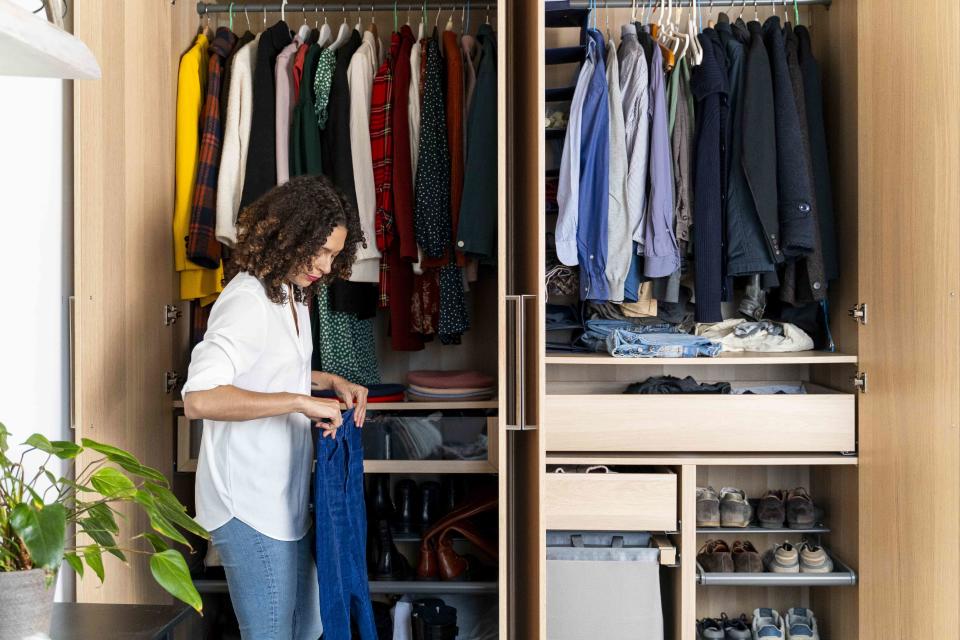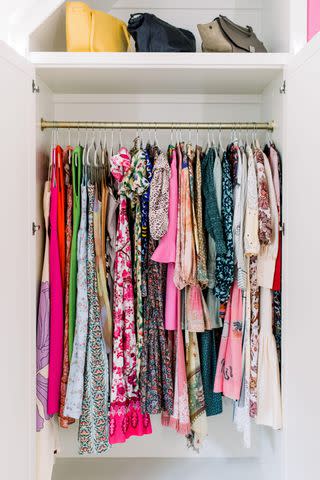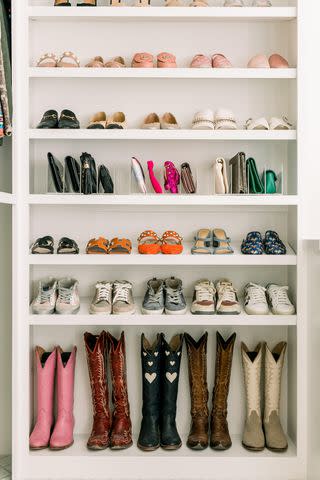10 Organization Mistakes You're Making In Your Closet
Avoid these common blunders for a cleaner, more coordinated closet.

Westend61/Getty
If finding what you’re looking for in your closet is an adventure in itself, you’re not alone. Overflowing, disorganized closets are an all too common problem, and so are ones that have undergone a big organization effort to no avail. Starting the process of arranging your closet can be intimidating, and it’s easy to make mistakes along the way. You can think yourself the owner of a highly organized closet and yet still struggle to find what you need in there.
Whether you’ve yet to start the process or find yourself with a seemingly-organized closet that isn’t quite as functional as you intended, easy fixes can help you optimize your space. Katia Basley, founder of Vision & Hammer, a home organization and interior design studio in Houston, Texas, says that she sees this all the time. If your closet is guilty of any of these oversights, Basley has just the advice for a well-organized and practical closet. You don't need a giant walk-in to find these organizational tips helpful, either. In no time, you’ll have a tidy, practical closet.
Mistake: Clearing Out
“The one we hear the most is people thinking they have to throw everything out and start fresh,” reveals Basley. Junking your current organization system, not to mention the abundant amount of clothes inside, is not the way to go, she tells us. Getting organized doesn’t have to mean throwing things out.
“Don't feel like you're not getting organized or you're not successful unless you throw things out,” Basley advises. “That's a misconception.”
The Fix: A Smart Disposal System
We’re not saying that you can’t get rid of things, just that you don’t need to. Hang on to the things that you use and find them a good spot rather than getting rid of them.
In order to trim down your closet inventory without it feeling like a big to-do, Basley recommends keeping a bag or bin in your closet designated as a donation pile. This way, if you discover that an article of clothing has gone untouched, you can throw it in there and keep collecting things over time to drop off at Goodwill at a later date.
Mistake: Heading Straight To The Store
A shopping trip is certainly the easiest part of a home project, especially with so many adorable storage organizers on the market. However, you should hold your horses before going shopping, Basley advises.
“The second mistake people make is spending too much money on new, fancy organizing materials,” says Basley. “You don't necessarily need to buy a lot and sometimes you can actually reduce your ability to organize if you start taking up space on a tiny shelf with big, clunky baskets."
The Fix: Take Stock Of What You’ve Got
"See what you have in your home already that would fit the space, but don't force it. Sometimes you might need to go buy things but before you get a ton of materials, do the research and take measurements,” Basley tells us. "This will help make sure that it's functional, cohesive, and looks great."

Becki Smith with Smith House Photo; Courtesy Vision & Hammer
Mistake: Tackling It All At Once
“Don't try to do it all at once. That's a big mistake people make,” Basley advises. “When you try to tackle a space all at once, you get overwhelmed. That's how a lot of spaces end up staying disorganized. Especially with a closet where there's tons of clothing, things wedged in drawers, seasonal stuff that you don't even want to think about, a big mistake is just trying to push yourself to get a ton done in a short period of time."
The Fix: Take Small Steps
Take baby steps, even, if that's what feels manageable to you.
“Taking small steps and checking something off everyday or every few hours is going to be a bigger win than trying to do too much all at once,” Basley says.
Come up with a plan that doesn't feel overwhelming to clean your closet over time.
Mistake: Leaving Clothes Vulnerable
Don’t take the decision of whether to fold or hang clothes lightly. Each article has its own needs to ensure upkeep. You don’t want to leave your favorite top open to unnecessary damage like annoying creases or moth bites. Putting a little extra time into the decision of what goes where can have a lasting impact on your clothes’ longevity.
The Fix: Mind The Material
“Think about the body of your clothing and what you're hanging versus what you're folding,” Basley tells us. “And, think about what materials things are made out of, so that they're being stored in a way that protects them and keeps them out of harm's way.”
To the best of your ability and as much as your space allows, find a home for each piece of clothing that makes sense for its individual needs.
“Of course at the end of the day, you only have what you have in terms of storage, so you might have to get creative if you don't have a ton of space,” she says.
Mistake: Wasted Wall Space
“People think they have to rely on drawers or a closet rod, but if you have wall space, there's a lot you can do with it,” says Basley.
Neglected walls are an opportunity for even more storage.
The Fix: Hanging Solutions
“Get creative, especially if you are in a small space, and try to use the walls,” says Basley. “There are so many places that you can put hooks and hang things. “You can get little acrylic adhesive hooks on Amazon and hang 20 hats on a wall, or scarves, or even a robe.”
Mistake: Lack Of Visibility
“A lot of people, especially if they want their closet to look pretty, will end up with a lot of baskets,” Basley reveals. “If you're putting something in a basket and you can't see the contents, you're probably never gonna go in there and what’s in there is just gonna sit there for a while.”
Clothing completely covered by others can similarly go out of sight, out of mind.
The Fix: Labels And Spacing
A more effective space will be one where nothing can go forgotten because everything is easily within your eye-line. For bins, Basley recommends labels as a helpful reminder of what’s inside. For hung clothes, use hangers of all the same size. This way, the clothes will all be visible in a neat line.
Mistake: An Evergreen Closet
“A lot of people feel like once they organize their closet, that's it. That's exactly how it has to be laid out forever,” Basley says. “But, don't be afraid to switch things up season to season.”
All year’s worth of clothes is too much for one closet to bear, especially if you live in a part of the South where the seasons mean diverse weather.
The Fix: Seasonal Storage
Ease the burden on your closet by cycling out clothes every season. Put away clothes that don’t suit the season’s weather and stock your closet with those that do. This can mean shifting out-of-season clothes up high in your closet, to shelves slightly out of reach or to another location like an attic or basement.
“Put things that are rarely going to be touched for a few months high so they're not taking up valuable real estate,” says Basley. “That's important so that you can actually see what you have for the season. When temperatures change, you know that everything else you need is ready to be brought down when you need it.”

Becki Smith with Smith House Photo; Courtesy Vision & Hammer
Mistake: Shoes On The Floor
If you have more than enough designated shelves for your shoes, lucky you; go ahead and move on to the next mistake. However, if you’re working with the floor as the host for your shoes, you’ll probably want to keep reading.
Keeping your shoes on the floor isn’t wrong, but there are wrong ways to do it, like organizing them only by color, for one. Basley has some helpful tips for making the most of your space to store your shoes without them being in the way.
The Fix: Save Stepping Space
Basley says that as a rule, put things that you don’t wear often up high, just out of comfortable everyday reach. She also highly recommends stacking sandals and flats on top of one another to save space.
“I know a lot of people will put their shoes by color, which is fun and looks pretty, but it doesn't make sense in the long run,” Basley adds. “I always recommend starting with the category for the shoes and then by color within the category if you want it to be color coded.”
Mistake: Low-Hanging Fruit
Often, people match their clothing organization with where there piece is worn on the body, Because pants are worn on the lower half, people often organize them towards the bottom of the closet, whether hung on a lower rack than their tops or folded on a lower shelf. Basley recommends doing the opposite.
The Fix: Hang Your Pants Up Top
“When it comes to your closet rod height and your personal height, you have to think about what's going to be in your face—what you are going to see in plain view. If the bulky shirts and sweaters are up high, it makes the closet feel a little bit more crowded, because it's right at eye level,” Basley tells us.
“So, I actually like to put slim pants, short skirts, things that don't feel as intrusive on the upper shelves, and then heavy sweaters and jackets down below. It just feels more spacious to have the skinnier things that take up less space at eye level.”
Mistake: Shallow Shelves
When it comes to shelves, the right depth is crucial. If the shelf is too shallow, and it won’t be able to fit everything you need them to, and storage organizers might not be compact enough. If a shelf is too tall, the things you stack there will also be too tall and likely to topple over.
The Fix: Stick To The Numbers
The right shelf height, Basley says, is 14- to 16-inches tall. Not too short, not too tall, and most store-bought store bins will fit right in.
For more Southern Living news, make sure to sign up for our newsletter!
Read the original article on Southern Living.

